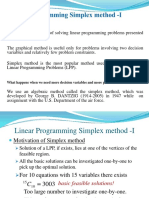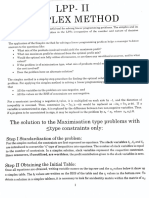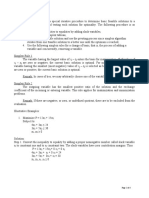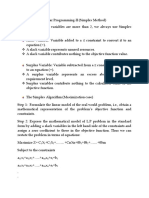Algorithms
Uploaded by
Suraj KumarAlgorithms
Uploaded by
Suraj KumarALGORITHM
Variables Xr and it is indicated by an arrow at the bottom of the rth column.
If there are more than one variable having the same most negative Zj-Cj any
one the variable can be selected arbitrary as the entering variable.
(a)If all Xir<=0(i=1,2,..m) then there is unbounded solution to the given
variable.
(b)If at least one Xir>0(i=1,2,…m) then the corresponding vector Xv enters
the basis.
For the solution of any LPP by Simplex algorithm the existence of an initial
basic solution assumed.
The following steps show how the optimal solution can be obtained.
Step 1: Check first whether it is maximize/minimize .If minimized then
convert it into maximization form by Min Z=Max(-Z)
Step 2: Check whether all bi(i=1,2,..m) are positive .If any one of the bi is
negative then multiply the inequality by -1 as to get to be positive.
Step 3: Express the problem in standard form by introducing Slack variables
to convert the inequality constraints into equations.
Step4: Obtain an initial basic feasible solution in the form Xb=B-1 and put it
in the first column of the simplex table.
Step5: Complete the net evaluations Zj-Cj; choose the most negative of
them. Let it be Zr-Cr for some j=r. This gives the entering.
Step6: Complete the net evaluations Zj-Cj = Cb(aj-cj), if Zj-Cj>=0, all then we
get the basic feasible solution ,if at least one Zj-Cj<0, then we go to the
next iteration.
Step7: If the column of the ratios be Xbi/Xik then choose the variable Xk to
leave the basic called the key row and the key column. The element at the
intersection of key row and key column is called the key element.
Step8: Form a new basis by dropping the leaving variable and introducing
the entering variable along with associated value under Cb column. Correct
the leading element to unity by the key equation by key elements in its
columns to 0 by using the formula:-
New element=Old element-[Product of the element in row and
key column]/key element
Step9: Goto step 5 and repeat the procedure until either an optimum
solution is obtained and there is an introduction of unbounded solution.
You might also like
- The Proposed Simplex Method For The Solution of Linear Programming ProblemsNo ratings yetThe Proposed Simplex Method For The Solution of Linear Programming Problems9 pages
- Linear Programming: Simplex Method: Dr. R. K Singh Professor, Operations Management MDI, GurgaonNo ratings yetLinear Programming: Simplex Method: Dr. R. K Singh Professor, Operations Management MDI, Gurgaon58 pages
- The Simplex Algorithm: Putting Linear Programs Into Standard Form Introduction To Simplex AlgorithmNo ratings yetThe Simplex Algorithm: Putting Linear Programs Into Standard Form Introduction To Simplex Algorithm25 pages
- Chapter 3 The Simplex Method and Sensitivity AnalysisNo ratings yetChapter 3 The Simplex Method and Sensitivity Analysis87 pages
- Simplex Method Is The Most Popular Method Used For The Solution of Linear Programming Problems (LPP)No ratings yetSimplex Method Is The Most Popular Method Used For The Solution of Linear Programming Problems (LPP)32 pages
- 02-24-01410 Optimization Lec05 LinearProgrammingNo ratings yet02-24-01410 Optimization Lec05 LinearProgramming45 pages
- Dr. Joon-Yeoul Oh: IEEN 5335 Principles of OptimizationNo ratings yetDr. Joon-Yeoul Oh: IEEN 5335 Principles of Optimization33 pages
- Chapter-6: Simplex & Dual Simplex MethodNo ratings yetChapter-6: Simplex & Dual Simplex Method17 pages
- Chapter 3, ND Vohra Book Linear Programming II:: Simplex MethodNo ratings yetChapter 3, ND Vohra Book Linear Programming II:: Simplex Method38 pages
- C4 - Simplex Method Jan 2021 (Autosaved)No ratings yetC4 - Simplex Method Jan 2021 (Autosaved)65 pages
- 3-Graphical Motivation For The Simplex MethodNo ratings yet3-Graphical Motivation For The Simplex Method19 pages
- Final MATH 304 - MODULE 3 - Final - 241002 - 145316No ratings yetFinal MATH 304 - MODULE 3 - Final - 241002 - 14531638 pages
- Lec5-Regular Simplex Method and Dual Simplex MethodNo ratings yetLec5-Regular Simplex Method and Dual Simplex Method48 pages
- Lecture 11 - Linear Programming, Graphical Method and Simplex Method VIIINo ratings yetLecture 11 - Linear Programming, Graphical Method and Simplex Method VIII12 pages
- (1d) Linear Programming - Simplex MethodNo ratings yet(1d) Linear Programming - Simplex Method32 pages
- A Brief Introduction to MATLAB: Taken From the Book "MATLAB for Beginners: A Gentle Approach"From EverandA Brief Introduction to MATLAB: Taken From the Book "MATLAB for Beginners: A Gentle Approach"2.5/5 (2)



























































